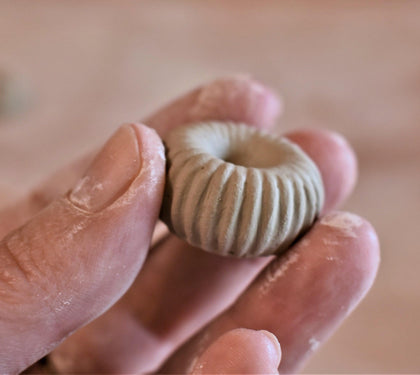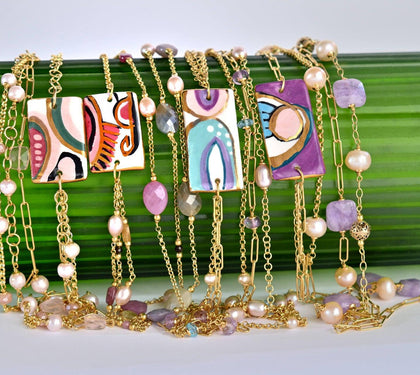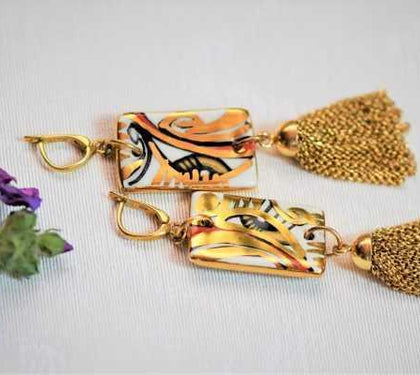The ceramics by Isotta are not often colored red simply because it is inspired by traditional Italian production, which prefers, for technical reasons, blues, greens and yellows to reds.
Red, in fact, was a difficult color to create; Red ocher was used for a long time in wall and ceramic paintings: the most famous example is "Pompeian Red". Another red borrowed from the Pompeian tradition is obtained by roasting yellow ocher, in order to make it darker.
Throughout the Middle Ages the search for a more stable and brilliant red continued; in the Mediterranean area, Lacca di Garanza was widely used, obtained from madder, which was also widespread in northern Europe and Flanders, or vermilion (the kermes ), extracted from an insect, a parasite of oak trees, although not very intense and rather unstable, and the mineral vermilion (mercury sulphide, or cinnabar), coming from mines in Turkey, which over time, however, turns to darker shades .
Pliny the Elder distinguishes the reds obtained from earths with colors such as cinnabar, from more valuable colors such as dragon's blood (a resin which is not very stable and therefore never widely used in painting, obtained from various species of plants, including dracaenae) and above all purpurissum , the very precious purple, inherited from the Phoenicians and obtained by fixing on clay the pigment extracted from marine molluscs of the Muricidae family.
Purple was so expensive that it was produced by combining it with reds of vegetal origin, such as red madder or madder. A much simpler and cheaper process whose result, moreover, was particularly stable, and which involved the roots of madder, already at the time of the great Middle Eastern and Mediterranean civilisations.
The traditions have also been handed down to us from the first treatise on painting in the vernacular written, between the 14th and 15th centuries, by Cennino Cennini: the treatise on painting . The same contains, among other things, a "practical recipe book" of the colors used in medieval and Renaissance painting. Cennino Cennini, in chapter XXXIX, illustrates the preparation of red cinnabar, lighter than sinopia, and will explain, in the following chapter XLI, to avoid red lead because "...if you use it on the wall, as you see the air it immediately becomes black, and loses its color” and advises against dragon's blood, in chapter XLIII, “which is not of a condition to do you much honor” and hairspray “which blackens in the air”.
Studying the masters of the sixteenth and seventeenth centuries, we will notice an evolution determined by the introduction of carmine, introduced at the end of the 16th century, at the time of the colonization of the New World, when cochineal arrived in Europe, which the Aztecs had used for centuries to extract red .
Warm and dark, carmine was an avant-garde color at the end of the 16th century, fashionable and very expensive. However, like its "younger brother", it was not very stable. Like true alchemists, masters such as Titian and Vermeer, Van Dyck and Rembrandt will offer humanity their extraordinary reds, combining reds from three different natural kingdoms (mineral for cinnabar and ocher, vegetal for madder, animal for vermilion and for carmine).
Painting will offer greater expressive possibilities than ceramics, allowing the superposition of multiple layers, especially in Venice, where rich merchants will offer painters a vast choice of pigments from all over the world.
Titian, for example, created intense reds by applying backgrounds of kermes which he then veiled with madder red, useful for making the color more stable: as in “ Noli me tangere”; over the years, the Master, as well as Giorgione, will also use cochineal carmine, like Paolo Veronese, who will prove to be a great interpreter of the most fashionable red, cochineal red, for example, in his “Allegory of Love I: infidelity ” of 1570.
In the seventeenth century the tradition was taken up by Dutch artists. Vermeer, for example, first spread a background of cinnabar and then superimposed a veil of red madder lacquer, as seen in "Two Gentlemen and a Girl with a Glass of Wine". The technique made it possible to protect the most delicate pigment from contact with the atmosphere, keeping it stable, and to make the color "deeper" and more varied.
Antoon Van Dyck and Rembrandt will thus create red symphonies, superimposing cochineal carmine on cinnabar backgrounds.
Not having the same chromatic opportunities offered in painting in the ceramic technique, I add a note of light, taking inspiration from the Umbrian Marche tradition, from which I received the use of metallic colors applied to third fire , namely gold. In merit, the beautiful productions of the centers of Deruta and the Duchy of Urbino (Gubbio, Urbino and Pesaro) have offered masterpieces in the history of Italian ceramic art that the world envies us; among these I remember with pleasure Mastro Giorgio da Gubbio.
When I make my ceramic products I apply clay-based engobes to the biscuit which have good coverage on large surfaces and are certified non-toxic (certified non-toxic in compliance with ASTM D-4236 standards) and, for the glossy finish, morning or crackle, I apply, on the engobed biscuit, a lead-free transparent crystal, by brush or by dipping.




